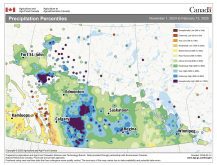Argentina’s drought, dry soil in the American southern hard winder wheat zone, U.S. President Donald Trump’s tough trade talk and a mostly welcome dump of snow in the eastern Prairies dominated the market news.
The U.S. Department of Agriculture updated its monthly supply and demand report last week, slashing Argentina’s soybean crop by seven million tonnes, pegging it at 47 million tonnes.
However, it is still behind local Argentina forecasts that put the crop at 40 to 45 million tonnes. Last year the country produced 57.8 million tonnes.
Read Also

Flax sector sees omega-3 opportunity
SASKATOON — A global shortage of omega-3 oils could be an opportunity for the flax sector, says an industry official….
Oilseed futures prices rose through February on the support of the Argentine drought. However, it was a case of buy the rumour, sell the fact as soybean futures fell following the USDA report.
The USDA numbers show that it thinks Brazil, with its record supply, will fill in for Argentina’s shortfall in soybeans.
The USDA trimmed its forecast for U.S. soybean exports and raised its year end stocks outlook. Adding to the negative tone was the fact the trade is uneasy about Trump raising tariffs on steel and aluminium. While Canada and Mexico received temporary exemption, the main focus remains on China’s metal exports, and it could respond by taking an increased liking of Brazilian soybeans over American product.
It was a different story in corn.
The USDA trimmed Argentina’s corn crop but said the gap in the world market would likely be filled by American exports rather than Brazilian. American corn exports have been picking up recently, but they will have to be very aggressive in the second half of the marketing year to match the USDA’s export target of 56.5 million tonnes.
The larger export number and a boost in the expectation for corn demand from ethanol makers resulted in the USDA lowering its year end U.S. corn stocks number to about 54 million tonnes, down from 59.75 million the previous month. It would also be tighter than last year’s year end stocks of 58.25 million tonnes.
That was the most price-supportive news in the corn market for some time. The market will closely watch the weekly USDA export numbers to see if reality matches the USDA’s optimistic export forecast.
Of course the USDA report was not so good for wheat prices.
U.S. wheat prices rallied into early March on the drought and poor crop conditions in Kansas, Oklahoma and Texas. However, the higher price makes U.S. wheat less competitive on world markets, and so the USDA reduced its outlook for American wheat exports and increased the forecast for year end stocks to 28.15 million tonnes, up 680,000 tonnes from the previous month and up about two million from the December report.
So while there is potential for a drought-reduced hard red winter wheat crop, the larger carry-in lessens the effect on total 2018-19 supply.
The wheat market is a hard one to call. If it remains dry in the southern U.S. Plains over the next few weeks as the long-term forecasts predict, the talk about damaged yield potential and abandoning winter wheat acres will increase. There could be another futures rally.
However, rallies in the wheat market tend to be short lived as traders soon shift attention to the potential for big crops again in the Black Sea region, Europe and elsewhere.
However, it is worth noting that although the wheat crop in Ukraine and Russia looks like it has come through the winter in mostly good condition, AccuWeather’s spring forecast raises the possibility of drought concerns in Russia’s Black Sea growing region and in eastern Ukraine.
Closer to home, the storm that dumped a lot of snow on eastern Saskatchewan and Manitoba was mostly welcome, given the dearth of precipitation this winter. However, the crop grows mostly on rain during the growing season, so we’ll have to see how April and May showers develop.
Canola futures have rallied along with the wider oilseed scene, even as rail problems hurt exports.
From week 25 to week 30 of the crop year Canadian port terminals received 788,600 tonnes of canola, only 58 percent of what they received in the same period last year.
The performance was only slightly better than the dismal 761,600 tonnes delivered in the same six weeks in 2014.
If the rail system can’t make up the lost ground once the weather improves, it will result in reduced exports and increased carry-out.
If you couple that with the potential for increased canola seeded acreage this spring, the recent gains seen in canola prices could be scaled back.














